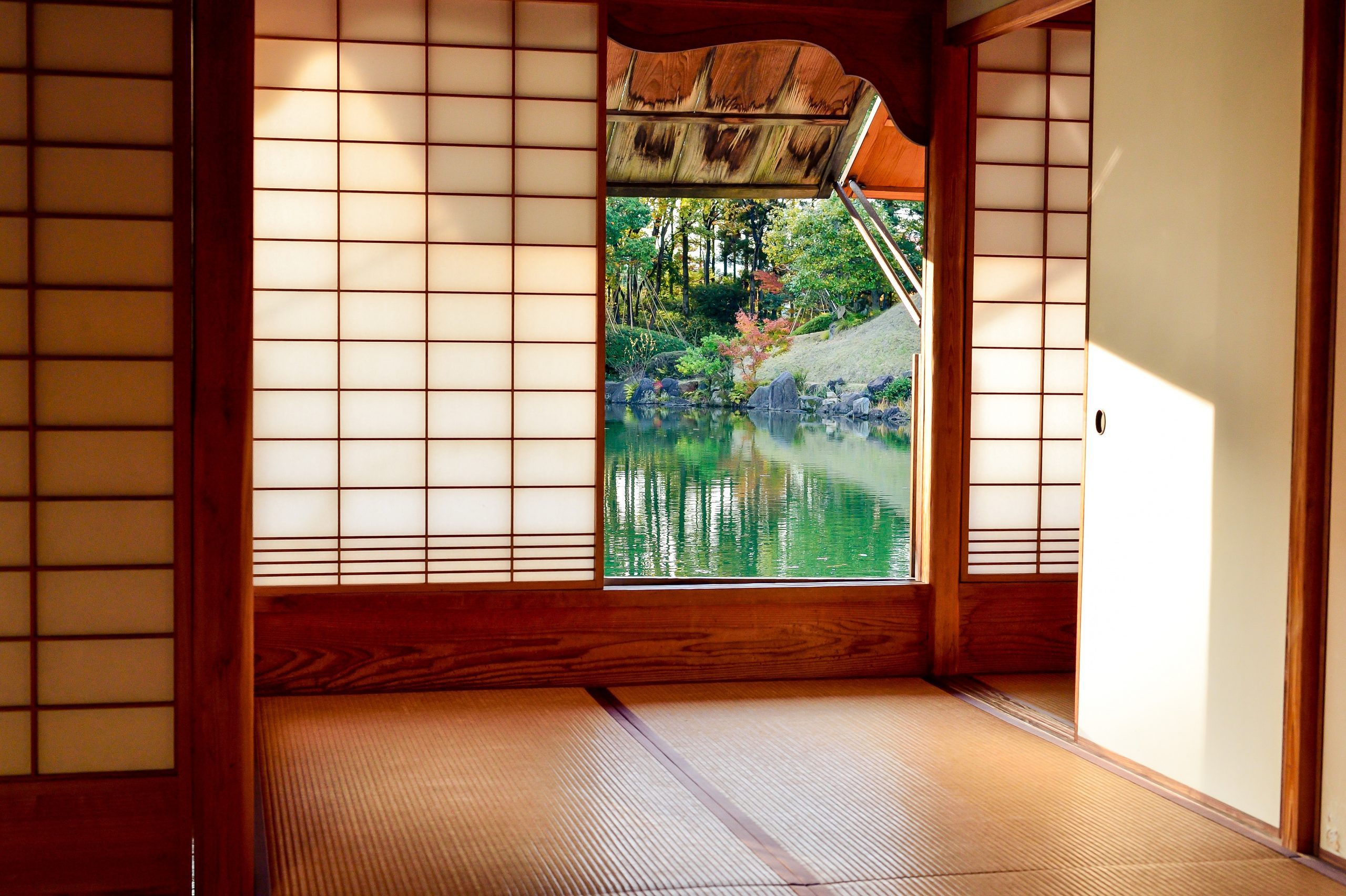Resilient vinyl flooring – both sheet and tile – has become a valued design tool for many interior designers and architects, particularly those designing for heavy-traffic locations – such as a grocery store – or for rooms that must be kept clean – such as a hospital operating room. In the following article, you’ll learn more about the possibilities and limitations of vinyl flooring, with a particular emphasis on commercial applications. This section will also address the design, environmental and historical considerations to take into account when specifying vinyl flooring.
Overview
Vinyl flooring is also called “resilient” flooring because it characteristically “bounces back” from the weight of objects that compress its surface. It has long been the most popular hard surface flooring in the United States, according to industry reports in Floor Covering Weekly.
Vinyl floors are available in either tile or sheet form for both commercial and residential use. Resilient flooring accounts for about 12 percent of all floor covering sold in the United States. (Other major categories include carpet, ceramic tile, hardwood and laminate.) New technologies in recent years have improved vinyl’s performance – especially in the areas of durability against rips, tears and gouges. Because resilient floors are durable, easier to maintain and more moisture-resistant than many alternative materials, vinyl is preferred for use in residential kitchens and bathrooms, as well as in healthcare facilities, and commercial and retail establishments.
In general, there are two types of vinyl flooring: sheet flooring and tile. In addition, there are two basic categories of vinyl tile – solid vinyl and vinyl composition – and three basic categories of vinyl sheet flooring – homogeneous, inlaid and layered composite. These products differ in manufacturing process and content. In fact, some floors contain as much as 55 percent vinyl (polyvinyl chloride or PVC) while others may contain as little as 11 percent vinyl, yet each of these floors is referred to as “vinyl flooring.” (In addition to vinyl resin, vinyl floors typically contain fillers, plasticizers, stabilizers and pigments.)
History
The following historical highlights help show how vinyl became popular for use in flooring.
The first rubber floor tiles debuted sometime in the 12th to 13th centuries, but declined in popularity toward the end of the 17th century. The use of plain, square, undecorated red clay tiles became common throughout Europe during the 18th century.
Linoleum was invented and patented in 1845. It was first manufactured in Scotland in the 1860s, and the first U.S. plant was built in 1872. Linoleum remained popular until after World War II, when easy-to-maintain and durable vinyl flooring was introduced.
In 1894, Philadelphia architect Frank Furness patented a system for rubber floor tiles. Colours were limited, but the tiles could be laid in geometric patterns to produce an eye-catching design. By the end of the century, recessed tabs allowed rubber tiles to be nailed to the subfloor, and soon the tabs were eliminated altogether. These tiles were durable, sound-deadening, easy to clean and easy to install. However, they also stained easily and deteriorated over time from exposure to oxygen, ozone and solvents, and were not suitable for use in basements where alkaline moisture was present.
The first cork tile floor was introduced in 1904, and became the most popular type of resilient flooring in the 1920s. It was available in a limited range of colours and designs, but was expensive and porous.
Asphalt tile arrived on the scene in the 1920s and, by the 1950s, was the most widely used floor tile on the market, fuelled by low initial cost and easy installation. These tiles were tough, durable, highly resistant to abrasion and moisture, and fire resistant, but the styles and patterns were limited.
Then, in 1933, vinyl made its big splash when a vinyl composition tile was displayed at the Century of Progress Exposition in Chicago. Because of the scarcity of vinyl during the war years, vinyl flooring was not widely marketed until the late 1940s, but then quickly challenged its competitors. Originally used only in high traffic areas, vinyl flooring eventually became the most popular choice for flooring in just about any hard-surface application. Today, vinyl flooring is second only to carpet in floor covering sales in the United States, according to Floor Covering Weekly.
Design Considerations
Product characteristics
Many factors should be taken into consideration when determining which flooring material to select for a specific application. For example, the flooring may need to stand up to rolling carts or support standing (static) loads. Moisture resistance may be critical, or resistance to fading. Each manufacturer can provide detailed information on the performance characteristics of its flooring, as well as proper installation and maintenance to avoid damage. You should expect long-lasting beauty from properly installed and maintained vinyl floors.
Design flexibility
Vinyl sheet flooring and tile are available in myriad styles and colours. Vinyl tile is available in shapes that can be custom cut and laid out in patterns using different colours or finishes. Tiles can be arranged, for example, to depict a corporate logo or to guide traffic in a hospital or retail setting. Virtually any look can be obtained to suit any decor, including classic looks that simulate wood and ceramic. Custom-made designs are easily created using sheet vinyl flooring.
Resilience
Vinyl flooring reduces noise and provides comfort underfoot. Unlike such hard surfaces as wood, laminate, terrazzo or ceramic tile, vinyl floors have “give” and thus are referred to as “resilient” flooring.
Durability
Vinyl flooring is durable and time-tested, maintaining its beauty under heavy foot traffic and use. It is moisture and stain resistant, so spills can be easily removed. When compared with alternative materials, vinyl offers an attractive installed cost with economical maintenance over the life of the floor.
Aesthetics
Today’s vinyl floors are made to enhance the aesthetic features of an interior environment. While often mimicking the look of other hard surfaces, they are “warmer” than ceramic tile. Designers can use pattern and colour to make a large room seem smaller or a small room more expansive. And since vinyl is durable, the colour and original appearance will last longer with routine maintenance.
Safety Features
A wide range of both tile and sheet vinyl floors is available with enhanced slip-retardant surfaces. These floors are suitable for a variety of commercial and institutional applications. Because they are vinyl, these slip-resistant surfaces can be easily cleaned. Check with manufacturers for vinyl floors designed to meet other special needs like static control.
Healthcare Applications
Vinyl flooring is frequently used in healthcare facilities because it is nearly impervious to water, offering a significant sanitary advantage over carpeting. These characteristics are particularly important in hospital rooms, extended care facilities, nursing homes and day care centres. Many commercial sheet vinyl floor installations offer sealed or welded seams that prevent contaminants from being lodged in the seam area. And with fewer seams than most other hard surface floors, bacteria has fewer places to hide and grow. Disinfectant cleaners can provide a sterile surface without damaging the floor. In addition, most stains can be easily removed. Check with the manufacturer for complete maintenance instructions.
For hypersensitive populations, where mould allergies may be a problem, vinyl flooring offers advantages as well. Researchers at the University of Nevada at Las Vegas have found that carpet can produce high airborne mould counts, which can actually be aggravated by vacuuming. Vinyl flooring, on the other hand, can be cleaned without dispersing high levels of mould into the air.
Sports facilities
Sheet vinyl flooring products can provide an attractive alternative to expensive wood flooring systems in gymnasiums, exercise rooms and other recreational areas. The no-wax stain-resistant surfaces of these floors mean lower maintenance costs and greater usage than traditional floors – and these surfaces will accept paint lines for use as a basketball, racquetball or volleyball court. High-density vinyl foam cushion backing systems provide a shock absorbing surface that reduces impact shock and leg fatigue. Many of these surfaces are protected by a clear wear layer and a high-performance, polyurethane surface and comply with NCAA basketball rules for bounce, rebound and hardness.
Limitations
Vinyl floors are not recommended for use in most commercial kitchens, although vinyl composition tile is commonly used in light duty kitchens and both tile and sheet vinyl floors are the leading choice for residential kitchens. Some vinyl floors can be susceptible to tears when heavy or sharp objects (such as cans or knives) are dropped. In addition, they can be subject to permanent indentation from static loads or damage from rolling loads. Vinyl flooring also may not be recommended for automotive maintenance areas or automotive showroom areas unless the flooring is protected from oil spills and contact with rubber tires. In addition, vinyl flooring is not recommended for outdoor installation, where excessive heat, cold or sunlight may cause fading and discoloration.
Technical Data
Manufacturers of vinyl flooring measure a variety of physical data, including the following. Manufacturers will vary their formulas to produce floors that meet standards in these areas. A single formulation may not meet all performance requirements, so specifiers must check with the manufacturer to determine the best flooring for the situation involved.
Loads
Impact loads, which are momentary indentations like those produced from walking traffic; static loads, which are any loads remaining in a stationary position for long periods of time; and rolling loads, which may damage resilient flooring especially immediately following installation.
Moisture Resistance
May be critical depending on the type of subfloor, since moisture conditions may affect adhesive performance. In most cases, resilient floors may be installed in areas where water might be spilled on the floor, providing the correct adhesive is used and the floor has a minimum of seams. (Spills should be mopped up immediately.)
Colourfastness
May be affected by exposure to strong sunlight.
Stain and Reagent Resistance
Will vary by product and manufacturer. Special formulations are available for use in areas where exposure to chemicals and staining reagents is likely to occur. In general, vinyl floors are resistant to alkalis, acids, alcohols, oils, greases and aliphatic hydrocarbons (e.g., gasoline, kerosene). Ketones (e.g., nail polish remover), esters (e.g., paint thinner) and chlorinated and aromatic hydrocarbons (e.g., naphtha, asphalt, coal tar) may cause softening.
Light Reflectivity
A measure of the percentage of light reflected off a surface, which may play an important role in the illumination of institutional, commercial and industrial facilities.
Acoustics
Of special importance in areas with heavy floor traffic. Resilient flooring, in general, will cushion impacts and thereby reduce traffic noise or noise from dropped objects more than other hard-surface floors such as wood, marble, ceramic or concrete. In addition, underlayments are available to further reduce impact noise and sound transmission.
Fire Retardance and Heat Performance
Most resilient floors are manufactured to be safe from normal fire hazards. In large-scale experiments that have been run to simulate actual fire conditions, vinyl flooring products have not been significant contributors to the spread of the fire or resulting hazards. In fact, vinyl flooring resists burning and typically does not continue burning when an external flame is removed. However, a resilient floor surface can be permanently damaged or scarred by burning cigarettes, matches or very hot items.


